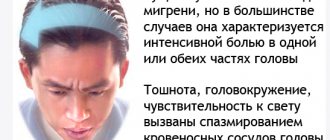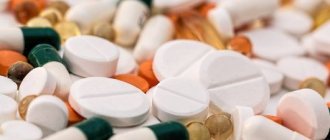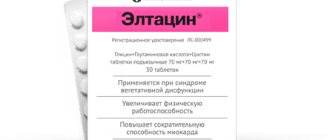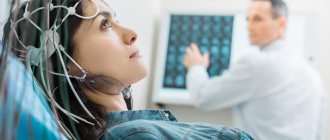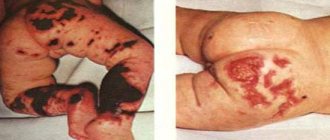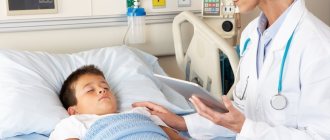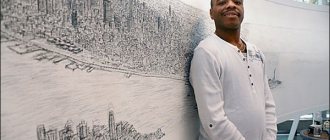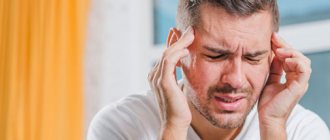Not so long ago, it was believed that migraine occurs only in adults, but recently a similar problem is often observed in children. This form of pathology is mainly found in children of primary school age, but can also occur in adolescents.
The symptoms of abdominal migraine in children are quite pronounced, since not only headaches are observed, but also pain in the abdominal area. Moreover, the child cannot always say exactly where it hurts. Often the pain is localized in the navel area, but can also affect other parts of the abdomen. In this case, the child experiences severe nausea.
Features of the disease
Symptoms of migraine in children do not always manifest themselves only in the form of a headache, since there are several complicated forms of this disease. Each of them has its own specifics.
One of these forms is abdominal migraine. This is a pathology of a neurological nature, in which the usual clinical picture is additionally accompanied by severe abdominal cramps. This condition often occurs in childhood, but can also occur in adolescence and in adults. In boys, the first manifestations of the disease are observed 2-3 years earlier than in girls.
Among the symptoms of migraine in children, it is necessary to highlight the occurrence of severe pain in the abdominal cavity, which is accompanied by malaise, headache, and nausea. Attacks occur periodically and especially severe pain is observed near the navel.
Due to the peculiarities of the development and course of the disease, it is quite difficult to diagnose it, which significantly complicates the treatment process. When the first symptoms of migraine appear in children, you should immediately visit a doctor for consultation, since incorrectly administered therapy will lead to aggravation of the situation and the emergence of even greater problems.
When diagnosing and treating the disease, special attention is paid to provoking factors. Identifying provocateurs and eliminating them allows you to minimize the frequency of exacerbations and reduce the intensity of attacks.
N.S. PavlenkoNovosibirsk State Regional Clinical Hospital
Recurrent headaches are one of the most common complaints among schoolchildren and adolescents. Among children 3 - 5 years old, the prevalence of headaches is about 3%, among children 6 years old it is already 15%, and among schoolchildren up to 82%, while the prevalence of frequent (daily) headaches among schoolchildren is 0.3-1.2% .
Migraine
Most researchers show that 2.5 - 10% of children experienced migraine attacks. About 30% of patients experience 1 or more migraine attacks per month. The ratio of boys to girls is 1:1.5. Migraine is characterized by a distinct set of clinical symptoms. Criteria for the diagnosis of migraine (International Headache Society, 1988): 1. Paroxysmal headache, lasting 2 - 72 hours. 2. Headache has at least 2 of the following characteristics:
- pulsating character;
- moderate to severe headache intensity (interferes with daily activities);
- unilateral localization of pain;
- increases with normal (routine) physical activity, e.g. walk.
3. Presence of at least one accompanying symptom:
- nausea;
- vomit;
- photophobia;
- phonophobia.
There are criteria for the diagnosis of migraine developed for children by Prensky (1976), according to which migraine in childhood is defined as repeated headaches (in the absence of pathological symptoms in the interictal period), accompanied by at least three of the following symptoms:
- abdominal pain, nausea, vomiting;
- unilateral localization of pain;
- pulsating nature of the pain;
- complete improvement in well-being after a short sleep;
- aura, which can be visual, sensory or motor;
- family history of migraine.
There are two main forms of migraine: migraine without aura and migraine with aura. An aura is a complex of focal neurological symptoms that precede an attack of pain or occur at the height of pain. Migraine with aura is characterized by complete reversibility of aura symptoms, none of the symptoms should last more than 60 minutes and the duration of the clear interval between the aura and headache should be no more than 60 minutes. The frequency of migraine with aura in children is higher than in adults (36 and 20%, respectively). Characteristic is polymorphism of the aura in one patient, a combination of vestibular, visual and autonomic changes. The predominant visual disturbances are narrowing of the visual fields, microphotopsia (ophthalmic aura), anopsia (retinal aura), Alice syndrome (distortion of the perception of the shape and size of surrounding objects, people’s movements are perceived at an accelerated pace, “like in a cartoon”, rarely ophthalmoplegic aura, usually in very young children. There are also hemi-paresthetic, hemiplegic, aphasic, cerebellar, vestibular forms of migraine. Basilar migraine is more common in teenage girls (dizziness, tinnitus, photopsia, parasthesia in the limbs, 30% - syncope). Autonomic or panic migraine - migraine in which an attack of headache provokes a panic attack (fear, tachycardia, hyperventilation, increased blood pressure, general weakness, lipothymia, polyuria). And finally, the types of migraine that occur mainly in childhood: abdominal migraine (paroxysmal pulsating pain in the abdominal area, sometimes accompanied by diarrhea and alternating with typical cephalgia), benign paroxysmal vertigo, hemiparetic form (hemiparesis that occurs in children 15-18 months old. lives with alternating sides, lasting no more than 60 minutes and having a clear genetic nature), dysphrenic migraine (paroxysmal behavioral disorders: aggressiveness, disorientation, irrational behavior lasting from several hours to 1-3 days, then children calm down, sometimes fall asleep, after waking up - headache), cyclic vomiting of infants.
Complications of migraine:
- Status migraine is a series of severe migraine attacks following each other with clear intervals of no more than 4 hours or one severe attack lasting more than 72 hours.
- Migraine stroke - one or more aura symptoms do not disappear completely after 7 days, and neuroimaging shows a picture of an ischemic stroke.
Factors that provoke migraine: emotional stress, physical activity, irregular meals (fasting), consumption of foods rich in tyramine (cocoa, chocolate, nuts, citrus fruits, cheese, smoked meats, eggs, tomatoes, canned food, fatty and spicy foods, etc.) .d.), cold water, ice cream, drinking alcohol, smoking, for girls the phase of the menstrual cycle is important, changing the usual sleep pattern (sleep migraine - attacks occur during night sleep in the REM phase), long rides in transport, sudden light, unpleasant odors, prolonged viewing of TV shows, weather changes, somatic diseases (diseases of the teeth, ENT organs, allergic conditions). It has been noted that people with certain psychological characteristics suffer from migraine: high level of aspirations, anxiety, high social activity, desire for leadership, good social adaptation.
The pathogenesis of migraine has not been fully studied. It is assumed that there is a genetically determined limbic-stem dysfunction, a violation of the metabolism of biologically active substances (serotonin, tyramine). Phase 1 - vasospasm in the basin of the external or internal carotid artery, while the blood supply to the vessels themselves suffers, which become especially sensitive to stretching. During this phase, there is an excessive release of serotonin from platelets, as well as norepinephrine (a tyramine derivative). Subsequently, serotonin is actively excreted from the body by the kidneys, its content decreases and phase 11 begins - vasodilation, the activated perivasal endings of the trigeminal nerve send pain impulses to the brain, BAS are released from its nerve endings (substance P, calcitonin, histamine), stimulating further vasodilation to complete atony and increasing the permeability of the vascular wall, which leads to perivascular edema (neurogenic inflammation) - phase 111. Phase 1V - reverse development of the process.
Migraine treatment:
- Stopping an attack. At the first signs of an attack, take paracetamol (15 mg/kg) or ibuprofen (10 mg/kg); if an attack develops, repeat at the same dose (in the first 2 hours). According to a number of authors, the effectiveness of taking paracetamol in children is 54%, ibuprofen 68%. These drugs suppress the synthesis of pain mediators - prostaglandins, kinins, etc. If NSAIDs are ineffective, dehydrotamine drugs, which have a powerful vasoconstrictor effect, are indicated. Dihydroergotamine is a non-selective serotonin agonist (ergotamine hydrogen tartrate - 0.1% solution 10-15 drops or 1-2 tablets, rigetamine - 1 tablet under the tongue, 0.2% dihydroergotamine solution, vasobral 1-2 ml, Divascan - tablet 2 ,5, novalgin suppositories, tonopan, dihydroergotamine nasal spray). Group 111 of drugs for the relief of migraine attacks - selective serotonin agonists - sumatriptan (the effectiveness in children is not clear, therefore it is not recommended for use in children and adolescents).
- Preventive treatment of migraine is indicated when the frequency of attacks is 2 or more per month. Non-drug methods - diet, daily routine, gymnastics, massage of the collar area, water procedures, IRT, biofeedback. Among the medications, β-blockers are the most widely used (propranololol at a dose of 10-20 mg with a gradual increase to a therapeutic effect, contraindications - asthma, depressive disorders), in second place are antidepressants (amitriptyline) and serotonin antagonists. tonin (methysergide, peritol), less often calcium channel blockers (nimodipine, verapamil), small antiplatelet doses of ASA (2-5 mg once a day, in the evening). The course of treatment is 2-3 months. The use of preventive therapy in children remains controversial, given the degree of possible side effects, as well as its questionable effectiveness (a 1995 study in the USA was conducted with a control group of children receiving placebo, which showed no effect of preventive therapy for migraine in children ).
The long-term prognosis of migraine in children is favorable in at least half of the cases, while in 1/3 of children migraine attacks stop altogether with age; the prognosis is more favorable for boys than for girls. With a frequency of migraine attacks of more than 1 per month, 50% of children continue to suffer from migraines into adulthood. About 1/3 of adults experienced their first attack in childhood. Typically, with age, the frequency of attacks decreases, but the intensity remains the same. Often both boys and girls get rid of migraines during puberty, then relapses are possible.
Tension headaches
The prevalence in school-age children is about 50% (70% in the general population), and chronic tension headache is 1%. It has been shown that 90% of all types of headaches are tension-type headaches.
TTH is defined as a headache that occurs in response to mental stress, which is the result of acute or chronic stress. Mental stress is accompanied by an increase in the tone of the frontal, temporal, occipital, and trapezius muscles, which spasm the vessels located in them, which leads to ischemia and edema and increases pain. Characterized by special personal characteristics of patients with a tendency to neurotic reactions and fixation on their somatic sensations. The specificity of the functioning of brain systems with a relative deficiency of the antinociceptive system is important.
Diagnosis criteria:
1. The duration of the headache is from 30 minutes to 7 days. 2. Headache has at least 2 of the following characteristics:
- tightening, squeezing, squeezing, monotonous nature of pain, “helmet”, “helmet”;
- headache is diffuse, bilateral;
- weak or moderate intensity, which does not exclude daily activity, although the quality of study and work undoubtedly deteriorates;
- The headache does not get worse with everyday physical activity.
3. The presence of the following accompanying symptoms: nausea, anorexia, photo- and phonophobia at the height of headache, these symptoms are mild, one of them may be present or less often all at the same time.
Episodic TTH - less than 15 days per month or less than 180 days per year (associated with stress).
Chronic tension-type headaches - more than 15 days a month or more than 180 days a year (lasting all day, every day).
Causes of HDN:
1. Psychosocial stress, depression and anxiety. Accompanied by complaints of increased irritability, constant feeling of tiredness, fatigue. Masked depression with various somatic complaints.
2. Prolonged muscle tension in antiphysiological positions: an uncomfortable desk, a desk that does not correspond to one’s height, while the eye muscles, muscles of the scalp aponeurosis, and neck are under tension (“school” headaches), uncomfortable posture during sleep.
3. Excessive, long-term use of analgesics
Provoking factors may also include changes in weather, strong winds, forced fasting, working in a stuffy room, physical and mental stress.
As a rule, such patients complain of pain in the neck, back, joints, heart, which are characterized by psychalgia, psycho-vegetative disorders are characteristic (fluctuations in blood pressure, heartbeat, hyperventilation, lipotimic states, fainting). In addition to anxiety and depression, there are also hypochondriacal personality traits.
Treatment of tension-type headache:
1. Treatment of episodic tension-type headaches primarily involves preventive measures: daily routine, adequate sleep, comfortable working conditions, non-pharmacological treatment methods - relaxing massage of the head and collar area, exercise therapy, IRT, biofeedback, autogenic training, psychotherapy aimed at increasing social adaptability -tations. For headaches, you can recommend a single dose of analgesics - paracetomol, etc., sirdaluda 2-4 mg/day.
2. Treatment of chronic tension-type headaches almost necessarily involves the prescription of antidepressants (amitriptyline) for a course of treatment of 2-3 months with gradual withdrawal. For severe asthenic manifestations, melipramine is preferable, as well as nootropic drugs. The course of treatment in general should not be less than 3-4 months and requires, first of all, patience from the doctor.
Cluster headaches
They are very rare in boys over 10 years of age, the prevalence in the general population is 0.5-0.1%.
Clinical characteristics - excruciating pain behind or around one eye, extends to hemicrania, without nausea, unilateral lacrimation, rhinorrhea, facial flushing, ptosis, miosis, occurs in clusters (bundles) lasting 3-16 weeks, attack lasts 15- 90 minutes, often waking up the patient at the same time during the night. At the biochemical level, the pathogenesis of cluster headaches involves an increase in the level of serotonin and histamine.
Usually the attack stops on its own before any medicine takes effect, the exception being the inhalation of oxygen. Drugs used for prevention are methysergide, CS, verapamil, sodium valproate.
Overuse headache
Overuse headache is a headache caused by regular chronic medication use in people who initially suffer from headaches. The headache is described as constant, persists throughout the day, is present upon awakening, diffuse, intensifies if a dose is missed, and is superimposed on the typical symptoms of migraine or tension-type headache.
Diagnosis criteria:
1. Develops three months after starting daily medication;
2. Minimum required dose of the drug (ergotamine - not less than 2 mg/d, aspirin - not less than 50 g/month, analgesic combinations - not less than 100 tablets/month, barbiturates - not less than 1 tablet/d, benzodiazepines - not less than 300 mg/month);
3. Chronic (at least 15 days per month);
4. Sharply worsens immediately after discontinuation of the drug;
5. Goes away 1 month after discontinuation of the drug.
The only method of treatment is quick and complete withdrawal of the drug, which is an abuse factor. In some cases (when addiction is caused by tranquilizers, barbiturates, when outpatient treatment is impossible, ineffective, in the presence of high anxiety and depression), withdrawal is carried out gradually in a hospital setting over 2-3 weeks. During the withdrawal period, the prescription of antidepressants is indicated.
Chronic post-traumatic headaches
By definition, they occur within the first 14 days after injury and last more than 8 weeks after injury. They have an independent nature, independent of the severity of TBI, often occur after mild TBI, when there is no clear morphological defect, and subsequently can have a progressive course. Apart from temporary criteria, they do not have clear clinical characteristics. Forms of chronic PTTH: tension-type headache, migraine-like, cluster, cervicogenic. Combined with neurotic complaints - emotional lability, irritability, fatigue, insomnia, memory loss, dizziness, weather lability, etc.
There is no serious evidence of the importance of liquor-dynamic factors, the development of a productive inflammatory process (arachnoiditis) in the formation of cephalgia syndrome after TBI. Recently, a mechanism of injury has been studied such as diffuse axonal damage (arising as a result of the “acceleration-deceleration” factor; as a result of acceleration, the cerebral hemispheres are twisted relative to the fixed brain stem, which leads to damage to long axons, i.e. white substances, integrative structures of the brain suffer, communication with limbic structures involved in the formation of pain behavior).
Over time, the importance of organic factors decreases, and psychosocial and iatrogenic factors begin to play a leading role. Trauma often only draws attention to disorders that pre-existed, i.e. “after” does not mean “because of.” TBI can also act as mental trauma. Anxiety arises for one’s health, the patient becomes fixated on the expectation of complications, in addition, the situation of “illness” can be beneficial for the patient (claims for damages, financial benefits), the patient’s position in the family changes (increased care, attention), pain justifies a passive line of behavior (avoiding difficulties). Drug abuse and prolonged bed rest are of significant objective importance.
Treatment is the same as for primary headaches. Post-traumatic tension headaches - NSAIDs, antidepressants, nootropics, muscle relaxants, post-traumatic migraine - the same as primary migraine, etc. The prescription of dehydration is neither justified nor effective. It is necessary to remember about psychological and social rehabilitation.
LITERATURE
- Antropov Yu.F. Algic manifestations of depression in children and adolescents. // Journal of Neurology and Psychiatry named after. Korsakova S.S. - 1999 - No. 3 - p. 12 - 15.
- Badalyan L.O., Berestov A.I., Dvornikov A.V. Headaches in children and adolescents. M., 1991. 60 p.
- Vein A.M., Avrutsky M.Ya. Pain and pain relief. M., "Medicine", 1997. P. 46 - 97.
- Vorobyova O.V., Vein A.M. Post-traumatic headaches. // Consilium medicum. - 1999 - No. 2 - p. 73 - 75.
- Kvaskova I.V., Shvornov S.B. Clinical manifestations of migraine in children. // Journal of Neurology and Psychiatry named after. Korsakova S.S. - 1999 - No. 1 - p. 15 - 17.
- Rogovina E.G. Features of migraine in childhood and adolescence. // Neurological journal. - 1999 - No. 4 - p. 27 - 31.
- Tabeeva G.R., Vein A.M. Chronic daily headache. // Consilium medicum. - 1999 - No. 2 - p. 68 - 72.
- Talitskaya O.E., Shvornov S.B. Cephalgic syndrome with autonomic dysfunction in children. // Journal of Neurology and Psychiatry named after. Korsakova S.S. - 1998 - No. 1 - p. 11 - 14.
- Feoktistov A.I., Filatova E.G., Vein A.M. Overuse headache. // Journal of Neurology and Psychiatry. Korsakova S.S. - 1999 - No. 12 - p. 58 - 62.
- Patric J. McGrath and G. Allen Finley, editors. Chronic and recurrent pain in children and ado-lescents. IASP Press, 1999. P. 115 - 140
Causes
Doctors cannot say unambiguously under the influence of what factors abdominal migraine develops in children, the symptoms of which cause significant discomfort. Even the mechanisms of development of such pathology have not yet been fully determined. Genetic predisposition and imperfection of the endocrine system in childhood are of no small importance. In addition, children are much more susceptible to external factors than adults. Doctors identify the following causes of abdominal migraine in children:
- the presence of anomalies in vascular development;
- hormonal disorders;
- deterioration of metabolic processes;
- insufficiently good blood circulation;
- low blood glucose levels;
- poor nutrition;
- irrational physical activity;
- emotional overstrain and stress.
TV or computer have a great influence, since if a child spends a lot of time in front of a screen, the likelihood of frequent headaches increases significantly. Negative external influences have a particular impact, in particular such as flickering light, too loud sound, monotonous hum.
If migraine symptoms appear in children under 10 years of age, then in adolescence this unpleasant disease can completely disappear after hormonal changes in the body. In some cases, attacks become very rare, and their symptoms become insignificant. Sometimes the disease can persist throughout life and begins to gradually fade away only in adulthood.
Are there complications after abdominal migraine?
When suffering from such a disorder, a person has many additional problems in addition to the main disease. For example, children cannot go to school and communicate normally with their peers, which leads to a decrease in grades and social skills. The disease can provoke:
- Chronic fatigue syndrome.
- Changes in behavior: irritability, loss of ability to concentrate on mental or physical activity for a long time.
- Depressive states.
- Development of hypochondriacal syndrome.
- Possibility of intestinal damage due to dysbacteriosis.
- Postoperative complications resulting from an incorrect diagnosis.
Main symptoms
The first symptoms of migraine most often appear in children under 12 years of age, and children aged 5-9 years are mainly susceptible to this disease. Signs of the disease may not be strongly expressed and, in addition, children still cannot say exactly what is bothering them. This makes diagnostics very difficult.
Among the symptoms of migraine in children, it is necessary to note the presence of headache, which mainly occurs in the frontotemporal part. Severe painful sensations have a significant impact on the child’s well-being and behavior. Children become capricious and cry for no reason or, conversely, may become lethargic and uncommunicative.
Basically, the disease occurs without an aura, that is, without visual symptoms, which manifests itself in the form of bright spots in front of the eyes, flickering light, or just fog. The periods between attacks can be quite long, up to several months, so parents often perceive the manifestation of the disease simply as the whims of their child.
It is very important to recognize the first signs and symptoms of migraine in children, as this will ensure faster and easier treatment. Among the manifestations of the disease, one should also note intolerance to strong odors, emotional overexcitation, irritation in bright light.
It is worth noting that a child suffering from an attack of abdominal migraine must be at rest all the time, so parents need to ensure strict compliance with this rule and create a comfortable environment for him. This type of pain is characterized by periodicity. The attacks are repeated after a certain time, and between them the child feels quite normal.
How does it manifest?
Experts include the most common complaints of people suffering from this disease:
- Sharp and prolonged pain that occurs at regular intervals of several weeks or even months.
- Diffuse discomfort occurs in the peri-umbilical area.
- Symptoms of anorexia appear.
- Nausea and a gag reflex are present.
- Diarrhea occurs.
- The skin begins to change color (pallor).
- Feeling of coldness in the extremities.
- A high pain threshold is observed in the morning.
- In some cases, behavior changes and frequent mood swings occur.
When a child’s body is damaged, the child is no longer able to lead full life activities, as children become capricious, whiny and nervous. Older children and teenagers often prefer bed rest and do not go to educational institutions.
Doctors note that most often, the duration of abdominal attacks ranges from 60 minutes to 72 hours. The pain disappears during sleep. In more patients, doctors diagnose a similar process almost every month.
Migraine in teenagers
Migraine symptoms in children 14 years of age are much more common than in children. This is explained by hormonal changes in the body, which result in various types of stress. The cause of this pathology is mainly overload with learning, which is often observed in schools. It is worth noting that migraine symptoms in children 16 years of age are mainly found in girls, which is determined by the hormonal characteristics of women.
The causes of this disorder are very similar to those in adults. A growing and developing child's body gradually adapts to various external and internal factors, which is why during this period there is significant stress on the nervous and endocrine systems. And this, in turn, causes the development of the disease.
Main factors causing abdominal migraine
At the moment, scientists have not been able to conduct a study that could show 100% of the sources that cause the appearance of the described disease. According to the tests carried out, it became clear that one of the main roles is played by the mental aspect, i.e. individual character development of the baby and parents, as well as mutual understanding in the family circle. Increased risks of disease progression are observed when the mother’s mental health is unstable.
AM often occurs in children with increased levels of anxiety, excitability, sensitivity and an increased degree of discomfort. The main reasons for this process to occur:
- Hereditary predisposition.
- Experiencing regular stressful situations and psycho-emotional overload.
- Increased sensitivity to changing weather conditions.
- Lack of sleep.
- Constant physical activity.
- Presence of hunger.
- Eating unhealthy foods.
Carrying out diagnostics
If the first symptoms of migraine occur in children under 10 years of age or older, you should definitely consult a doctor for diagnosis and subsequent treatment. Initially, you need to distinguish the disease from various types of problems with the gastric system, as well as other organs.
Particular attention during diagnosis is paid to the genitourinary system of the body. To make an accurate diagnosis, the doctor takes into account the existing symptoms. This disease is characterized by the following symptoms:
- headache;
- pale skin;
- photophobia;
- nausea;
- excessive sweating;
- abdominal pain.
In addition, the doctor studies the family history and finds out whether any of the relatives have had migraine attacks. This is very important, since the disease is mainly hereditary. In this case, it is much more difficult to treat. If migraine is abdominal in nature, then attacks occur periodically, only a few times a year, and the rest of the time the child’s health is quite satisfactory.
If a child often suffers from migraine attacks, it is necessary to keep a journal in which the duration of the attack, the symptoms of the aura, as well as all the events that preceded the onset of discomfort are recorded. In addition, the following diagnostic measures may be required:
- Dopplerography of the brain;
- encephalography;
- radiography;
- tomography.
Only after a comprehensive examination will the doctor be able to make the correct diagnosis and prescribe appropriate treatment.
Basilar migraine
Changes occur in the area of the blood supply to the basilar artery, so the episodes have characteristic symptoms.
An aura is characterized by tinnitus, imbalance, double vision, speech disorders, disturbances of consciousness, decreased hearing acuity, and flashes before the eyes. These symptoms are short-lived and go away on their own within a few minutes. If there are at least two of the listed symptoms, we can talk about the basilar form. After the aura, a unilateral throbbing headache appears. Sometimes it is not very strong; the warning signs of an attack cause more trouble to the patient.
How to relieve an attack
To improve the child’s well-being and relieve severe pain, it is recommended to put him to bed. It is advisable to first ventilate the room well to ensure access to fresh air. The child needs to create a calm and comfortable atmosphere. It is recommended to apply a cool compress to the forehead.
A light massage of the temporal and occipital parts of the head will help to cope with painful sensations. The movements performed should be as relaxing as possible. During a severe attack, vomiting can relieve the child's condition. However, if there is nausea, but there is no vomiting itself, you can induce it yourself by giving your child boiled, lightly salted water to drink.
How to treat
Treatment of the disease is based on relieving pain during an attack using a number of drugs.
Drug therapy includes:
- triptans – effective against migraines (Sumatriptan, Eletriptan);
- non-steroidal anti-inflammatory drugs – relieve pain and inflammation (Ibuprofen, Naproxen);
- antiemetic drugs - to relieve attacks of nausea and vomiting (Motilium, Metoclopramide);
- antidepressants – to relieve stress and improve sleep (Fluoxetine, Sertraline).
Attention! The selection of medications is carried out only by a neurologist based on the individual characteristics of the body and the nature of the attacks.
The patient must be kept at rest in a quiet, darkened room with free access to oxygen. The patient is also advised to take soothing chamomile or mint tea.
Features of treatment
This disease has a completely uncharacteristic course for ordinary migraine, which often makes it difficult to make a correct diagnosis. The main problem in providing timely treatment is that children complain only of abdominal pain, and as a result, they are treated for completely different diseases.
When characteristic symptoms of migraine appear in children, treatment should be carried out by a neurologist who prescribes appropriate medications and other therapies. The doctor determines which treatment method to choose after conducting a comprehensive diagnosis. You must follow a special diet and exclude harmful foods, caffeine-containing and carbonated drinks from your usual diet. Migraines can be triggered by spices, which is why they should also be excluded.
You should not allow your child's stomach to be empty during the day, but you should also make sure that he does not overeat. You need to consume food in small portions several times a day. Stressful situations should be avoided in every possible way; the educational process should be combined with walks in the fresh air and games. Sports are appropriate, but only in moderation, and the child must choose what exactly he wants to do. You should try to minimize your child’s time at the computer, since it has been proven that computer games reduce vision and lead to migraines.
During an exacerbation of an attack, it is necessary to limit exposure to irritating factors, especially sharp sounds and smells, as well as bright light. The doctor selects all medications for the treatment of migraines in children individually and controls their dosage. Despite the fact that the signs of the disease decrease over time, it is necessary to undergo periodic examinations with a doctor. Sanatorium-resort treatment will be very useful, especially in case of a bad environmental situation.
The mechanism of abdominal migraine
At present, the pathogenesis of the described disease has not been found. Malfunctions in the functioning of the human body have a functional plan and are associated with the appearance of certain factors that have a direct impact on the central nervous system and gastrointestinal tract. One of the main assumptions of experts in this field is that during stress, the nervous system is activated, which subsequently entails a high release of special elements of the body.
There is an assertion that disturbances in stable functioning lead to supersensitivity of intestinal structures, which in turn causes stretching of the intestinal surface and provokes superpulsation, which sends to the spinal cord and proceeds further.
Drug therapy
To quickly and effectively eliminate the symptoms of abdominal migraine in children, treatment is carried out using drug therapy. Medicines help make the child feel better, as well as reduce the frequency and intensity of attacks. The treatment regimen is drawn up by a neurologist, taking into account the patient’s age, symptoms, and provoking factors. To eliminate the symptoms of abdominal migraine in children, treatment involves the use of drugs such as:
- anti-inflammatory drugs;
- painkillers with a sedative effect;
- antimigraine;
- according to indications - antiemetics.
It is worth noting that anti-migraine drugs are used only if other medications do not bring the required result. Ergotamines and triptans are not prescribed in childhood, as they have a pronounced negative effect on the child’s body. Their use is carried out in the most extreme cases and only under the supervision of a doctor.
To eliminate the symptoms of migraine in children, comprehensive treatment must be carried out. Medicines based on ibuprofen and paracetamol, in particular such as Panadol and Nurofen, will help cope with pain. Sometimes caffeine-containing drugs, such as Askofen and antihistamines (Cetrin), can help.
To achieve a more positive result, sedatives such as Sedafiton, Novo-Passit and antidepressants (Deprim) are prescribed. Throughout the entire period of therapy, it is necessary to take vitamin complexes that will help normalize well-being and prevent the frequent development of relapses.
When the first symptoms of migraine appear in children, treatment must be carried out immediately, since the course of the disease, as well as the likelihood of complications, largely depends on this.
Treatment Options for Abdominal Migraine
The main methods used by doctors are the basics of treating simple migraines. However, the entire therapeutic course must be carried out as a complex and include a reduction in the severity of AM attacks. The correct treatment plan is prepared by an expert in the field of neurology. Treatment methods:
- Therapy for paroxysm is the use of drugs such as paracetamol and having a non-steroidal anti-inflammatory effect, as well as taking drugs containing codeine.
- In special cases with a high level of restriction, doctors prescribe medications of their triptan group.
- Components that have an antiemetic effect are prescribed.
- Children are given an injection of valproic acid.
Consequences
In some cases, the child experiences a severe course of the disease, when migraine attacks continue for several days. This condition is considered very dangerous, since the process of developing an attack becomes uncontrollable, and painkillers have no effect.
During a severe attack, the vessels of the brain fill with an excessive amount of blood and expand, which can lead to oxygen deficiency in the brain and its swelling. In addition, a prolonged attack can lead to a migraine stroke. In this case, the symptoms of the disease persist even after the attack disappears.
Carrying out prevention
Abdominal migraine attacks occur completely unexpectedly. So far, there are no ways in medicine to prevent them. However, doctors recommend following a number of rules, knowledge of which helps reduce the frequency of exacerbations and improve a person’s quality of life. Disease prevention includes the following:
- maintaining a correct lifestyle;
- normalization of psycho-emotional state;
- active leisure;
- conducting physiotherapy sessions;
- drug support for the body.
It is imperative to exclude from life factors that cause stress and nervous disorders. Moderate physical activity, walks in the fresh air, trips to the sea are required.
To strengthen blood vessels, therapeutic exercises, contrast showers, and aromatherapy will be useful. It is also necessary to periodically conduct courses of vitamin therapy and use drugs whose action is aimed at eliminating the causes of the disease. Prevention is recommended even for those children who have never experienced signs of abdominal migraine.
Diagnostics
Making a diagnosis for such a pathology is quite difficult, since the set of symptoms characteristic of abdominal migraine may indicate other diseases.
To make a diagnosis:
- Ultrasound of the abdominal organs to identify pathologies;
- taking an anamnesis to determine genetic predisposition;
- determining the exact symptoms of an attack, the nature and location of pain;
- blood and urine tests.
In rare cases, if a diagnosis cannot be made, an electroencephalogram or computed tomography is performed.
The diagnosis of “abdominal migraine” is made when:
- no problems with the gastrointestinal tract;
- presence of genetic predisposition;
- the coincidence of the symptoms described by the patient with signs of abdominal migraine;
- the occurrence of an attack more than 5 times.
